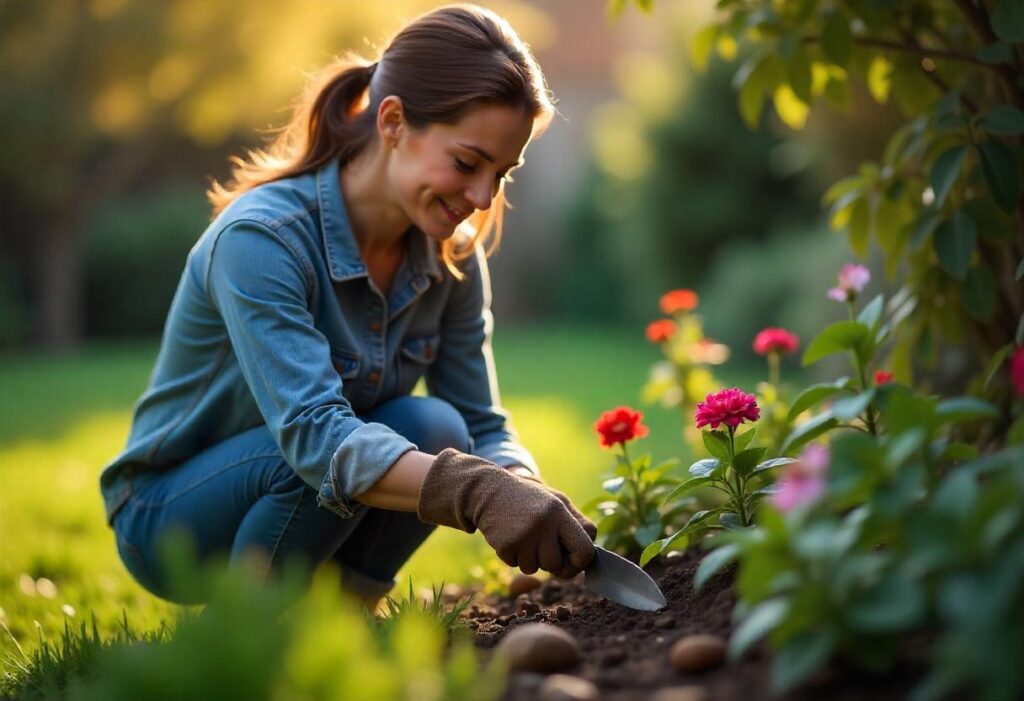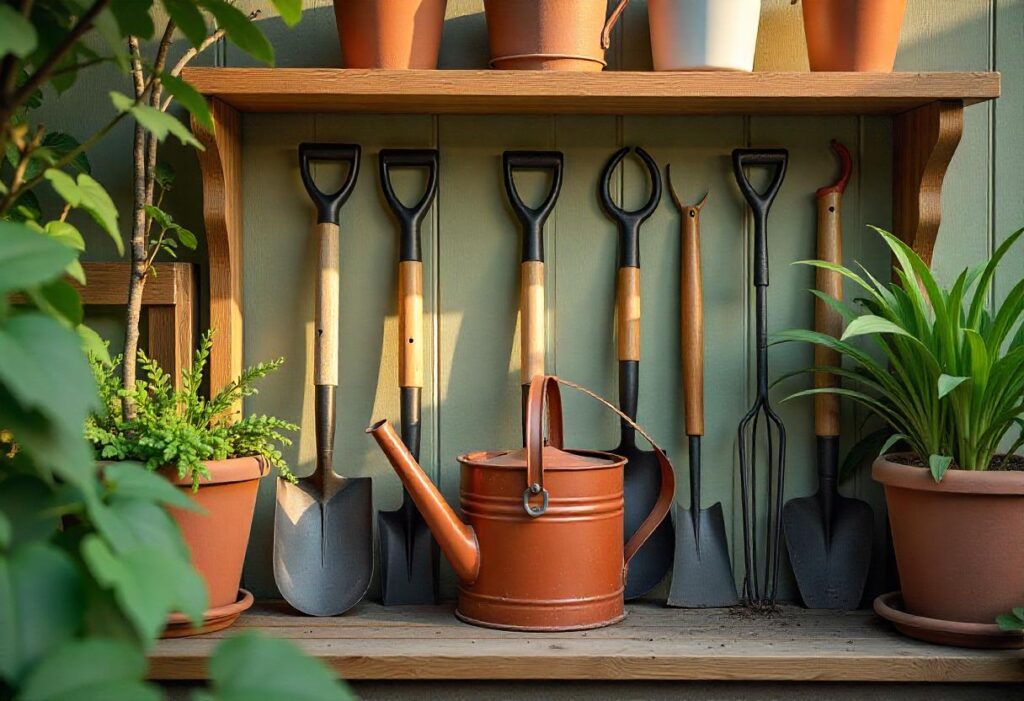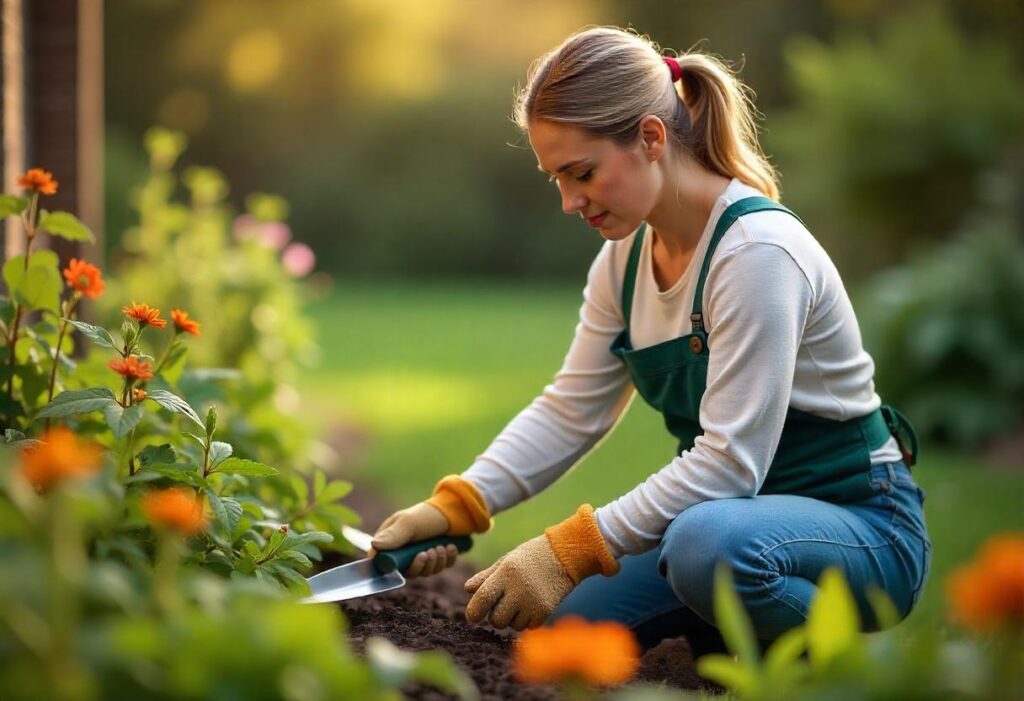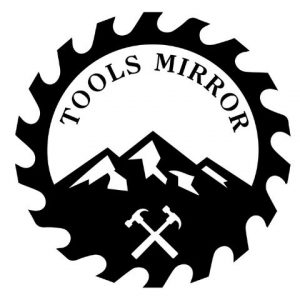The best gardening tools for a vegetable garden include a trowel, pruning shears, and a garden fork. These tools make planting, trimming, and soil preparation easier.
Growing your own vegetables is one of the most rewarding ways to connect with nature and improve your diet. But to cultivate a thriving vegetable garden, having the right tools can make all the difference. Whether you’re a beginner or a seasoned green thumb, this guide covers the essential gardening tools every vegetable gardener should have in their shed.

Why the Right Tools Matter?
Ever tried digging through compacted soil with your bare hands or pulling out stubborn weeds without proper gloves? Not fun. The right gardening tools not only save your time and energy but also make your work more precise, efficient, and enjoyable.
How Gardening Tools Improve Efficiency?
From prepping the soil to pruning your tomato plants, each tool has a purpose. With the proper gear, tasks that used to take hours become quicker, cleaner, and more productive—plus, your plants will thank you for it.
Essential Gardening Tools for Every Vegetable Garden
Let’s dig into the must-have tools for your veggie patch.

Essential Hand Tools
Every gardener needs the right tools. Hand tools are primary tools for maintaining a healthy vegetable garden. They help with planting, weeding, and soil preparation.
Let’s explore some essential hand tools first.
Hand Trowels
Perfect for Planting and Transplanting
A trowel is a small hand tool. It is perfect for digging and planting. Trowels come in various shapes and sizes. Choose one with a comfortable grip. Stainless steel trowels are durable and rust-resistant. A trowel should have a sturdy blade. This helps in breaking up soil easily.
Hand Forks
Breaking Up Tough Soil with Ease
A hand fork is another must-have tool. It is used for loosening soil. Hand forks have three or four tines. Look for one with strong tines. This makes it easy to turn and aerate soil. A good hand fork is also helpful in removing weeds. It can reach areas where larger tools cannot.
| Tool | Usage | Material |
|---|---|---|
| Trowel | Digging and Planting | Stainless Steel |
| Hand Fork | Loosening Soil | Steel |
Using the right tools makes gardening easier. It ensures your vegetable garden thrives.
Versatile Digging Tools
Every vegetable garden needs versatile digging tools. These tools make planting and soil preparation easier. They help you dig, turn, and move soil with ease. Here, we focus on two essential tools: spades and shovels.
Spades
Spades are crucial for precise digging tasks. They have a flat, rectangular blade. This design makes them perfect for cutting through tough soil and roots.
| Type of Spade | Best Uses |
|---|---|
| Border Spade | Great for digging narrow trenches. |
| Digging Spade | Ideal for breaking tough soil. |
Spades are versatile and strong. They help you with various gardening tasks. Choose a spade with a strong handle and a sharp blade.
Shovels
Shovels are essential for moving soil and compost. They have a curved blade, making them perfect for scooping and lifting.
- Square Shovels: Best for moving soil and compost.
- Round-Point Shovels: Ideal for digging and planting.
Shovels come in different sizes. Pick one that fits your strength and height. Ensure the handle is comfortable and the blade is durable.
Effective Weeding Tools
Weeding is crucial for a healthy vegetable garden. Weeds steal nutrients and water from your plants. Using the right tools makes weeding easier and more effective. Here are some of the best weeding tools for your garden.
Weed Pullers
Weed pullers are a must-have tool. They help remove weeds by the roots. This prevents regrowth and keeps your garden clean. Here are a few types of weed pullers:
- Dandelion Diggers: These have a long, narrow blade for deep roots.
- Hand Weeders: Small and easy to use, perfect for tight spaces.
- Stand-Up Weeders: Great for large areas, no bending required.
Garden Hoes
Great for Weeding and Soil Preparation
Hoes are versatile and effective. They cut weeds at the soil surface. This stops weeds from growing back. Here are some popular types of hoes:
- Draw Hoes: Traditional design, great for breaking up soil.
- Stirrup Hoes: Oscillating blade, excellent for slicing weeds.
- Dutch Hoes: Push-pull action, very efficient for weeding.
| Tool | Best For | Advantages |
|---|---|---|
| Dandelion Diggers | Deep-rooted weeds | Removes entire root |
| Hand Weeders | Tight spaces | Easy to use |
| Stand-Up Weeders | Large areas | No bending required |
| Draw Hoes | Breaking up soil | Traditional design |
| Stirrup Hoes | Slicing weeds | Oscillating blade |
| Dutch Hoes | Weeding | Push-pull action |
Pruning Essentials
Pruning is key for a healthy vegetable garden. It helps plants grow better and produce more. Using the right tools makes pruning easy and fun. Let’s explore two must-have pruning tools: pruners and loppers.
Pruners
Keeping Your Plants in Shape
Pruners or pruning shears are small, hand-held tools. They are perfect for cutting small branches and stems. Pruners fit comfortably in one hand. They are ideal for precise cuts. Here are some features to consider:
- Blade Material: Stainless steel blades stay sharp longer.
- Handle Design: Ergonomic handles reduce hand fatigue.
- Locking Mechanism: Safety locks keep blades closed when not in use.
Pruners come in two types: bypass and anvil. Bypass pruners are great for live plants. Anvil pruners work well on dead or tough branches.
Loppers
Loppers are larger than pruners. They have long handles for extra leverage. Loppers are perfect for cutting thick branches. Here are some key features:
| Feature | Benefit |
|---|---|
| Blade Length: | Long blades cut through thick branches easily. |
| Handle Length: | Extended handles provide better reach and leverage. |
| Cutting Mechanism: | Ratchet or gear mechanisms make cutting easier. |
Loppers also come in bypass and anvil types. Choose bypass for live wood and anvil for dry wood.
Watering Solutions
Watering your vegetable garden is crucial. Plants need consistent moisture to thrive. The right tools make this task easier and more efficient.
Watering Cans
Watering cans are essential for small gardens. They allow for precise watering. This prevents over-watering and root damage.
Choose a watering can with a long spout. This helps reach plants without bending. A can with a removable rose is versatile. Use the rose for gentle watering, or remove it for a steady stream.
Consider the material of the watering can. Plastic cans are lightweight and durable. Metal cans are sturdy and often have a classic look. Ensure the handle is comfortable for easy carrying.
Hose Nozzles
Hose nozzles are ideal for larger gardens. They attach to your garden hose and control the water flow. This saves water and targets specific areas.
Look for a nozzle with multiple spray settings. Options range from a gentle mist to a powerful jet. This versatility is great for different types of plants.
Adjustable nozzles allow you to customize the water pressure. This is important for delicate seedlings and mature plants. A nozzle with a trigger lock reduces hand fatigue. This feature is helpful during long watering sessions.
Metal nozzles are durable but heavier. Plastic nozzles are lighter but might wear out faster. Choose a nozzle that fits comfortably in your hand.
Soil Preparation Tools
Preparing your soil is the first step to a thriving vegetable garden. The right soil preparation tools make this task easier and more efficient. Below, you’ll find essential tools to prepare your garden soil.
Rakes
Rakes are crucial for leveling and smoothing your garden soil. They help remove debris and stones, ensuring a clean planting surface. Here are some types:
- Bow Rake: Ideal for breaking up clumps and spreading soil.
- Leaf Rake: Best for gathering leaves and light debris.
Consider the handle length and material for comfort and durability. A sturdy rake can make soil preparation less tiring.
Cultivators
Cultivators break up hard soil and mix in nutrients. They are effective for loosening soil and removing weeds. Here are the types:
- Hand Cultivator: Good for small garden beds and tight spaces.
- Rotary Cultivator: Ideal for larger areas needing deeper tillage.
Choose a cultivator that fits your garden size and soil type. Ergonomic designs reduce strain and increase efficiency.
Investing in quality soil preparation tools lays the foundation for a successful vegetable garden. Happy gardening!
Planting Aids
For a thriving vegetable garden, having the right planting aids is essential. These tools simplify the planting process, ensuring that seeds and plants are positioned correctly for optimal growth. Below, we discuss two important planting aids: transplanters and bulb planters.
Transplanters
A transplanter is a must-have for any vegetable gardener. This tool helps move seedlings from pots to the garden bed without damaging roots.
Key features of a good transplanter:
- Sturdy Handle: Ensures a firm grip.
- Sharp Blade: Makes precise cuts in the soil.
- Measurement Marks: Helps plant at the correct depth.
Using a transplanter is simple. Follow these steps:
- Dig a hole in the soil.
- Lift the seedling with the transplanter.
- Place the seedling in the hole.
- Fill the hole with soil.
Here is a comparison table of popular transplanters:
| Brand | Material | Price |
|---|---|---|
| Fiskars | Stainless Steel | $15 |
| Corona | Carbon Steel | $12 |
| Wilcox | Aluminum | $18 |
Bulb Planters
A bulb planter is designed to create perfect holes for planting bulbs, tubers, and seedlings. This tool makes planting quick and easy.
Key features of a good bulb planter:
- Comfortable Handle: Reduces hand fatigue.
- Depth Gauge: Ensures consistent planting depth.
- Durable Material: Withstands repeated use.
Using a bulb planter involves simple steps:
- Press the planter into the soil.
- Twist to create a hole.
- Lift the planter, taking soil with it.
- Drop the bulb into the hole.
- Release the soil back into the hole.
Here is a comparison table of popular bulb planters:
| Brand | Material | Price |
|---|---|---|
| Yard Butler | Steel | $20 |
| Edward Tools | Stainless Steel | $15 |
| Garden Weasel | Aluminum | $25 |
Protective Gear
Gardening can be fun and rewarding. But it also has some risks. To stay safe, you need the right protective gear. This gear helps prevent injuries and keeps you comfortable. Let’s look at two key items: gloves and knee pads.
Gloves
Gloves are essential for any gardener. They protect your hands from dirt, cuts, and thorns. Choose gloves made of durable materials like leather or nitrile. These materials are tough and long-lasting. Look for gloves that fit snugly but are not too tight. This ensures you can move your fingers easily.
- Leather gloves: Best for heavy-duty tasks.
- Nitrile gloves: Ideal for delicate work and waterproof.
- Fabric gloves: Good for light tasks and breathable.
Knee Pads
Working in a vegetable garden often means kneeling. This can be hard on your knees. Knee pads provide cushioning and protection. They reduce the strain on your knees and make gardening more comfortable. Look for knee pads with adjustable straps. This ensures a snug fit and prevents slipping.
| Type | Features |
|---|---|
| Foam knee pads | Lightweight and comfortable |
| Gel knee pads | Extra cushioning and durable |
| Hard-shell knee pads | Best for rocky or uneven surfaces |
Specialized Tools for Better Yield
These tools go beyond the basics but can greatly enhance your gardening game.
Raised Bed Rake
Designed for leveling and smoothing soil in raised beds, this tool helps you create the perfect planting surface.
Soil pH Tester
Knowing your soil’s pH can make or break your vegetable yield. Many veggies thrive in slightly acidic soil—test and adjust as needed.
Power Tools to Save Time and Effort
When you’re ready to step things up, these power tools are worth the investment.
Electric Tiller
Ideal for larger gardens, an electric tiller quickly breaks up soil and prepares it for planting.
Battery-Powered Pruner
Say goodbye to hand strain! These handy gadgets slice through branches with ease.
Garden Shredder
Turn yard waste into mulch or compost material fast with this powerful helper.
Tips for Storage & Maintaining Your Gardening Tools
Gardening tools can last for years with proper storage and maintenance. Keeping tools in good condition ensures they work efficiently.
Taking care of your tools means they’ll take care of your garden.
- Cleaning and Storing Tools Properly – Always wipe down tools after use. Store them in a dry, cool place to prevent rust.
- Sharpening Blades Regularly – Dull blades make more work. Use a sharpening stone or tool to keep shears and hoes effective.
| Kit Component | Use |
|---|---|
| Sharpening stone | Ideal for sharpening blades. |
| Honing oil | Reduces friction during sharpening. |
| File | Perfect for rough edges and larger tools. |
Use these kits regularly to maintain tool performance. A sharp tool makes gardening easier and quicker.
- Oiling Metal Parts – Prevent rust and keep moving parts smooth with a little oiling now and then.
- Use Tool Organizers – Tool organizers help keep your gardening tools neat and accessible. They can be wall-mounted or free-standing.
- Wall-mounted racks: Save space and keep tools off the ground.
- Tool sheds: Offer a dedicated space for all your gardening gear.
- Toolboxes: Great for small tools and easy transport.
Consider the size of your garden and the number of tools. Choose an organizer that fits your needs.
How to Choose the Right Tools for Your Garden?

Shopping for tools? Keep these factors in mind.
Consider Your Garden Size – Smaller gardens need fewer, lighter tools. Larger spaces may call for heavy-duty gear.
Match Tools to Your Physical Needs – If you have arthritis or limited strength, look for tools with ergonomic designs and padded handles.
Look for Durable and Ergonomic Designs – Invest in quality materials like stainless steel and hardwood handles—they’ll last for years.
Budget-Friendly vs. Premium Tools
Not everything needs to break the bank.
What to Buy Cheap?
Items like gloves, plastic pots, or basic watering cans can be budget-friendly.
When to Invest More?
Spend more on pruners, hoes, and trowels—tools you’ll use often and rely on.
Eco-Friendly Gardening Tool Options
Want to stay green while gardening? Choose tools made from recycled materials, bamboo handles, or solar-powered gadgets. Many brands now offer sustainable options without compromising quality.
Mistakes to Avoid When Buying Gardening Tools
- Buying kits with unnecessary tools
- Choosing tools that are too heavy or too light
- Ignoring comfort and grip
- Opting for low-quality metal that rusts fast
FAQs
What Is The Most Useful Gardening Tool?
The most useful gardening tool is a hand trowel. It helps with planting, transplanting, and weeding efficiently.
What Tools Do Professional Gardeners Use?
Professional gardeners use tools like pruners, shears, spades, trowels, rakes, hoes, and wheelbarrows. They also rely on gloves, watering cans, and garden forks. These tools help maintain and enhance garden health and appearance.
What Is It That All Gardens Must Have?
All gardens must have sunlight, water, soil, and plants. These essentials ensure healthy growth and vibrant greenery.
What Tools Are Used In A Vegetable Garden?
Essential tools for a vegetable garden include a trowel, hoe, rake, watering can, pruners, and gloves. These tools help with planting, weeding, watering, and maintaining plants.
What Are Essential Gardening Tools?
Essential tools include a trowel, pruners, gloves, watering can, and a garden fork.
How do I maintain my gardening tools?
Clean them after use, store them properly, sharpen blades often, and oil metal parts to prevent rust.
Are electric garden tools worth the investment?
Yes, especially for larger gardens or gardeners with limited strength. They save time and reduce effort.
Can I use the same tools for flowers and vegetables?
Absolutely! Most tools are versatile, though some may be optimized for certain tasks.
What is the most versatile gardening tool?
The hand trowel—perfect for digging, transplanting, and even weeding in tight spaces.
Conclusion
Whether you’re just starting out or you’re a seasoned green thumb, the right tools can elevate your vegetable gardening experience. From basics like gloves and trowels to advanced gear like electric tillers, there’s something for every gardener. Choose wisely, maintain them well, and your garden will flourish like never before.
Recent Posts
Woodworking in 2025 is all about efficiency, precision, and smart technology. Whether you're a beginner or a seasoned craftsman, having the right tools can make all the difference. Here are the top 7...
Ever tried drilling into a piece of wood only to end up with a splintered mess or a wobbly hole? Yeah, it's more common than you think. Wood might seem like an easy material to work with, but...

